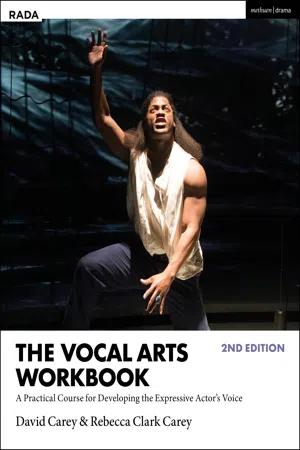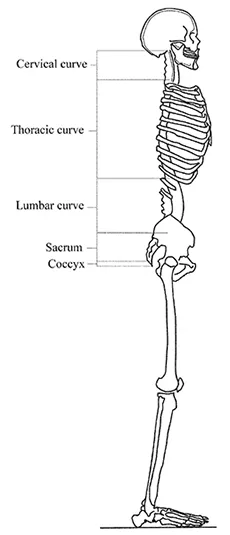![]()
1
BODYWORK
Framework
It may seem strange to begin work on your voice with work on your body, but it is your body that produces your voice. In order to tell any kind of meaningful truth with your voice, your whole self needs to be available. Physical tension and unconscious physical habits can shut down that availability. The work of this chapter will help to open it back up again.
In theory, it’s not hard to grasp that physical tension is undesirable. We all know how uncomfortable we feel and how disadvantaged we are in situations that make us tense – when the shoulders tighten, the jaw clenches, the breathing becomes shallow and the stomach churns. But even though there are physical tensions that we associate with stress and long to be rid of, there are also physical tensions that we associate with passion, commitment and intensity; and, frankly, on some level we cherish and nurture them. Often, the more physically worked up actors get, the more they may feel they are really acting. The muscles, however, make no distinction: tension is tension, and tension very often gets in the way of effective performance.
Of course, a certain amount of muscular activity is necessary just to sit upright; complete relaxation would be an absurdity. The key question is whether the muscles are engaged in a way that supports your intention or undermines it. Muscles either engage (contract) or disengage (relax). The word tension is used to describe a muscular contraction which is either unrelated to the task (e.g. squinting your eyes to pick up something heavy) or is inappropriately strong. Boxers throwing a punch generate a tremendous amount of energy by strongly engaging certain muscles, but excess contraction in those muscles or surrounding muscles will actually block that energy and could cause a boxer injury. Actors playing a scene of high intensity likewise need to engage strongly, not only physically but also mentally and emotionally, but excess muscular contraction will block their expressive energy by stiffening the body and squeezing the voice. Powerful communication happens when energy flows through a channel (physical, vocal, emotional, mental) that is open, responsive and free.
Of course, just as it is possible to confuse tension with passion and intensity, it is also possible to confuse disengagement with ease and naturalness. In vocal terms, this often means using minimal breath energy and actually increasing tension in the jaw and tongue root, creating a sound that’s held back, a little gravelly and flat. Sometimes this is referred to as ‘speaking on one’s vocal fry’. In and of itself, there’s nothing wrong with this kind of casual voice, but if your muscles don’t know any other way to function, you’re going to be quite limited in your expressive choices as an actor. And it’s not the same thing as true relaxation. The relaxation and release that we will work to achieve come not from holding energy back, but from freeing it to come forward; not from tuning out, but from paying attention.
Where do the tensions that get in our way come from? Babies and young children are usually geniuses at employing the exact amount of muscular effort necessary to get the job done. Their bodies tend to be free and beautifully aligned. We use the word ‘alignment’ to refer to that posture which is most physiologically efficient – that is, the posture which requires the least amount of muscular activity to stay upright. It involves what Alexander Technique teacher Glynn Macdonald calls the ‘dynamic relationship between head, neck and torso’ (1998: 39).
To see healthy children of two or three walking, crouching, running or simply sitting on a stool is to observe creatures that have an intuitive awareness of good, physiologically efficient posture: they are in balance, their centre of gravity is stable in their pelvis, and their head/neck/torso relationship is in dynamic alignment. But over time – under the influence of various elements of their environment, such as diet, emotional or physical distress, or the myriad unconscious choices about how they want to appear that children and adolescents will make as their bodies and minds grow – the instinctive awareness of the healthy body can become numbed. Stubbed toes teach us not to swing our legs so freely. Teasing or other forms of social pressure can cause us to want to shrink or puff up. Fashion magazines teach us to hold in our stomachs and thrust our hips forward. The body is a sponge; it absorbs all of these influences and holds on to them for a long time. As a result, we can literally become ignorant of the knowledge our bodies were born with: knowledge of how the body feels when it is balanced, knowledge of where our centre of gravity is, and knowledge of how the spine works to support and sustain the dynamic relationship between the head, neck and torso. This kinaesthetic knowledge is vital for the Vocal Arts.
Thankfully, if we listen to our bodies, we can become resensitized to the messages they are giving us, and we can reinforce our instinctive knowledge with more conscious awareness. A number of body practices can achieve this reawakening, but our experience has led us to use a combination of Alexander Technique, Qi Gong (or Chi Kung) and Yoga. Alexander Technique is a programme of physical and mental training created by the Australian actor and voice teacher, F.M. Alexander, and it is founded in the principle that the way we use our body affects the way it functions. By focusing on simple activities like standing, sitting and breathing, Alexander Technique encourages conscious awareness of muscular tensions and behavioural habits in order to develop an improved use of the body. Qi Gong is a Chinese system of exercises designed to unblock energy within our bodies and develop ‘internal strength’ (Chuen 1991). Again, through simple activities like standing, breathing and stretching, it encourages the release of mental and physical tensions in order to increase the healthy functioning of mind and body. Yoga is an Indian system of exercise and meditation which was originally designed to achieve spiritual union with the Absolute. Today, particularly in the West, its focus on postural stretches and breathing is often used to reduce stress and improve physical and mental fitness. These practices help attune us to what has been called our ‘sixth sense’ – proprioception, or the kinaesthetic awareness of our body’s state of balance, its posture and the muscular activity we use to move through space. As we learn to listen to this kinaesthetic sense, we can become aware of how the head can balance on top of the spine, how the whole body can be aligned to achieve a sense of ease and energy, and how we can use muscles efficiently to enhance our movement potential.
Of particular importance for our vocal practice is the spine. The spine consists of four main sections, all of which are intimately related to areas of the body responsible for producing the voice: there are the seven cervical vertebrae which make up the neck and connect with the voice and speech organs in the head, throat and larynx; there are the twelve thoracic vertebrae to which the ribs attach, and which are thus connected to the lungs and respiratory muscles in the chest; there are the five lumbar vertebrae in the small of the back to which respiratory muscles of the diaphragm and abdomen attach; and there are the five fused vertebrae of the sacrum – the base of the spine – which attaches to the pelvis and so relates to the deep breathing muscles of the abdomen and the pelvic floor. These four sections (plus the coccyx, our vestigial tail bone) create a sequence of gentle curves in the spine that make a dynamic whole (see Figure 1). Distortions of these curves, however, will have an immediate effect on the voice. Too pronounced a curve in the lumbar area, for example, or a collapse in the thoracic vertebrae will affect the management and capacity of breathing. Likewise, if the neck is twisted or shortened, the functioning of the vocal muscles in the larynx will be impaired and the size and shape of the vocal resonators in the throat and head will be diminished.
Figure 1 The spine and physiologically efficient posture
Efficient alignment of the spine, or good posture, may feel odd to you at first. However, as Kristin Linklater has pointed out in her seminal book Freeing the Natural Voice (1976, revised 2006), what feels familiar may not actually be what is natural – that is, what your body would do if it had not been subjected to stress, strain and habit. Good posture can also make you feel vulnerable. Many postural habits are acquired in response to self-consciousness – about one’s height, one’s weight, one’s body shape, etc. So, raising your head or letting your abdominal muscles relax or bringing your shoulders back may make you feel very exposed. It’s okay to feel that way, but it’s also important that you have the courage to stick with it. The work of this chapter is not only physical. As you explore what it means to become more released, relaxed and aligned, you will also have the opportunity to discover what it is to be more present in your body and more accepting of your whole self. This will make it possible and safe for you to transform as an actor, thereby becoming a more powerful teller of stories.
Teaching tip
Because the patterns of muscular tension are acquired unconsciously and over time, they can become very deeply ingrained, and the work on releasing them is never really finished. Our approach to this issue is eclectic: progress can be made through...

